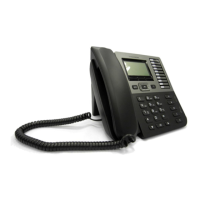TB30s SIP Administrator Guide v1.3 Page 8 of 259
Configuration:
IP Number addressing: manually configured via local setup menu, static or dynamic IP
configuration (integrated Dynamic Host Configuration Protocol DHCP)
Configuration support:
Local & remote warm reboot
Network start up via DHCP and TFTP (Trivial File Transfer Protocol)
TFTP/HTTP sever download
Web browser management
Password protection for configuration
Phone set function support and Call Options:
Call hold, Call Transfer, Call Forward, Conference Call, Call Park and Call Pick-up.
On-hook dialing, Dial from call log, multi line (10 lines)
Redial, Mute, Call log, phone book (30 entries), 10 Speed dial memory keys
Hands free (full-duplex)
Supported Protocols
Your TB30 SIP Phone supports the following standard Internet protocols:
Internet Protocol (IP)
IP is a network layer protocol that sends datagram packets between nodes on the Internet.
IP also provides features for addressing, type-of-service (ToS) specification,
fragmentation and reassembly, and security.
User Datagram Protocol (UDP)
UDP is a simple protocol that exchanges data packets without acknowledgments or
guaranteed delivery. SIP can use UDP as the underlying transport protocol. If UDP is
used, retransmissions are used to ensure reliability.
Trivial File Transfer Protocol (TFTP)
TFTP allows files to be transferred from one computer to another over a network.
Dynamic Host Control Protocol (DHCP)
DHCP is used to dynamically allocate and assign IP addresses. DHCP allows you to
move network devices from one subnet to another without administrative attention. If
using DHCP, you can connect TB30 IP phone to the network and become operational
without having to manually assign an IP address and additional network parameters.
Domain Name System (DNS)
DNS is used in the Internet for translating names of network nodes into addresses. Sip
uses DNS to resolve the host names of end points to IP addresses.
Hyper Text Transfer Protocol (HTTP)
HTTP is the underlying protocol used by the World Wide Web. It defines how messages
are formatted and transmitted, and what actions Web servers and browsers should take in
response to various commands.
Simple Network Time Protocol (SNTP)

